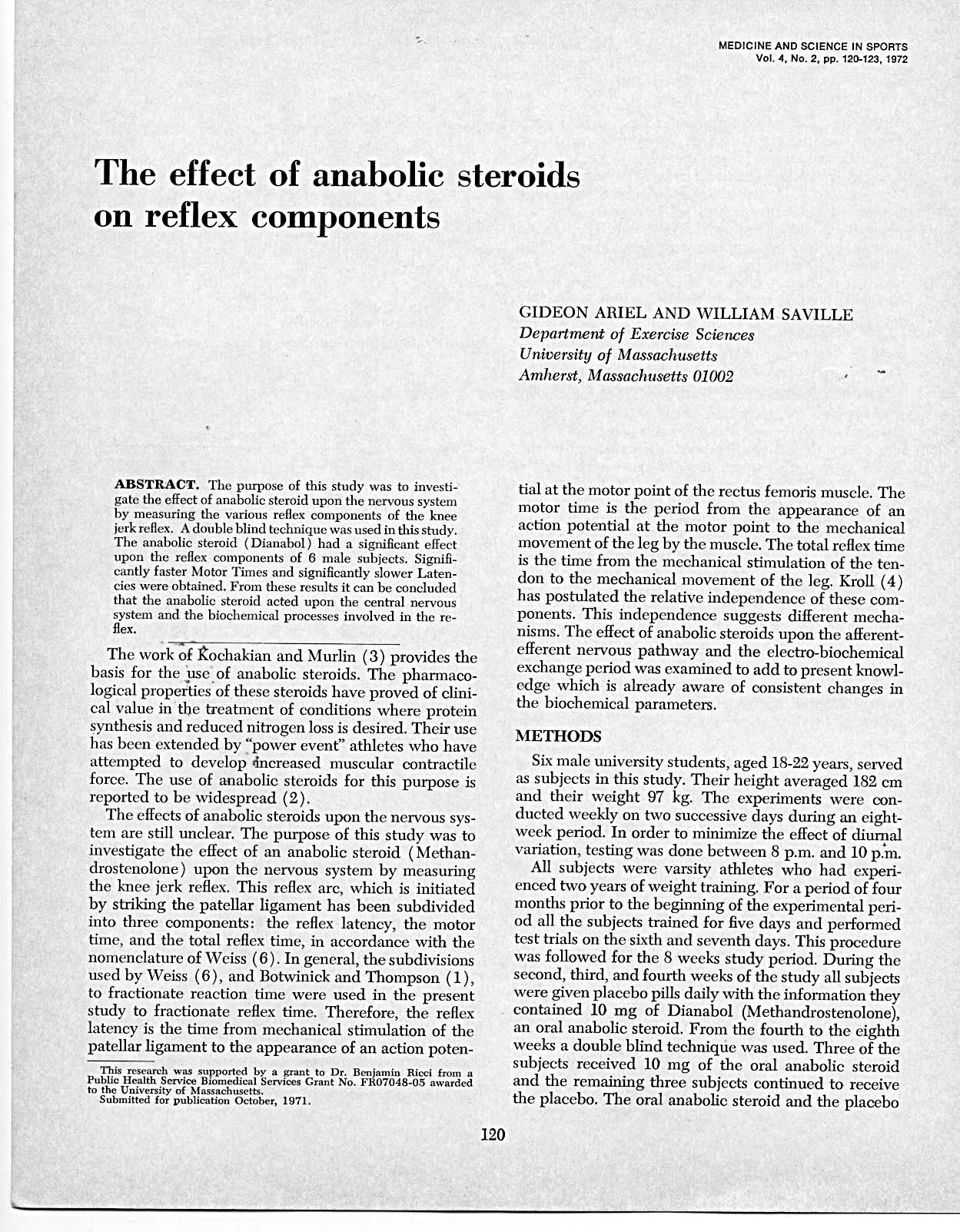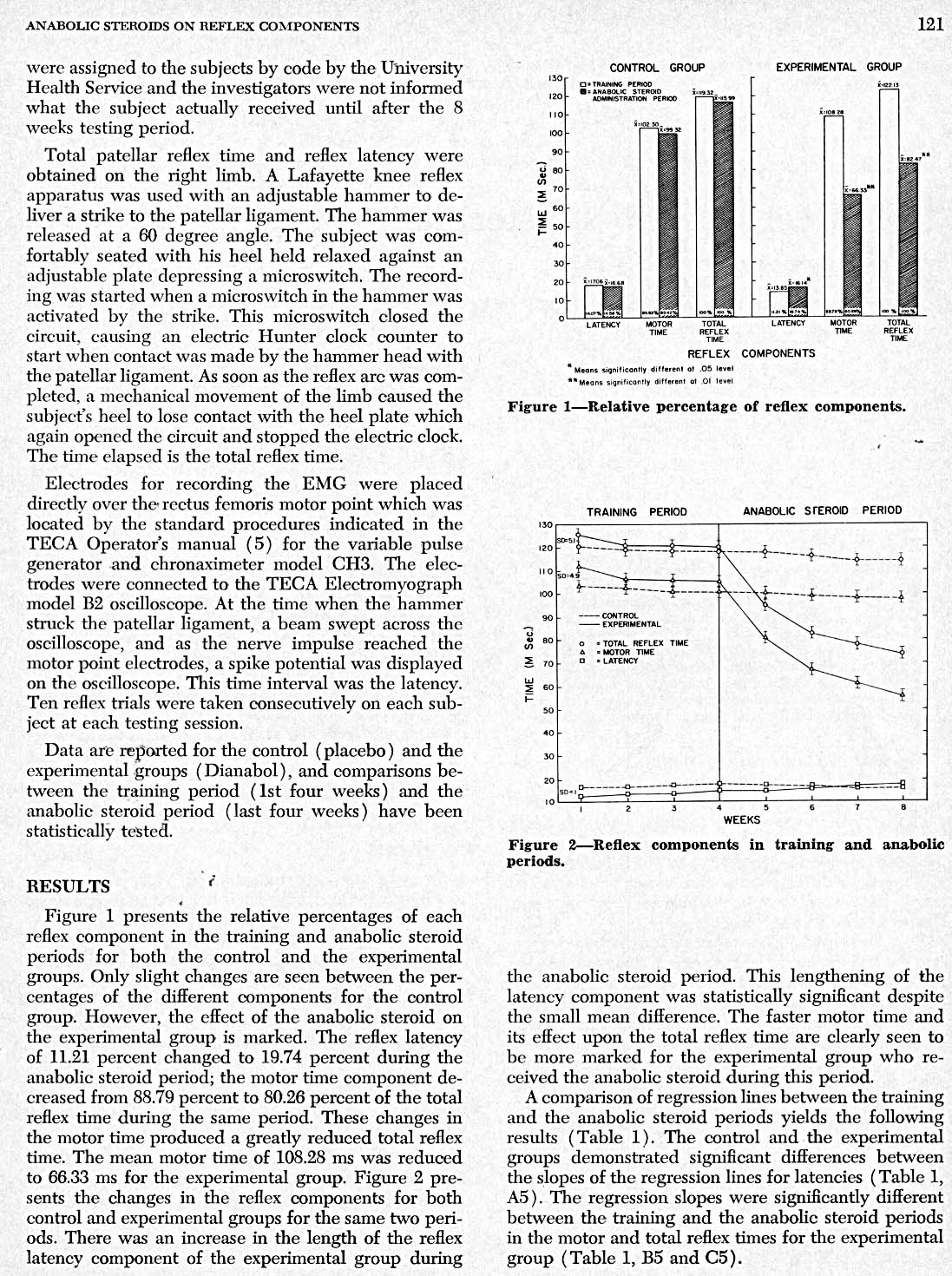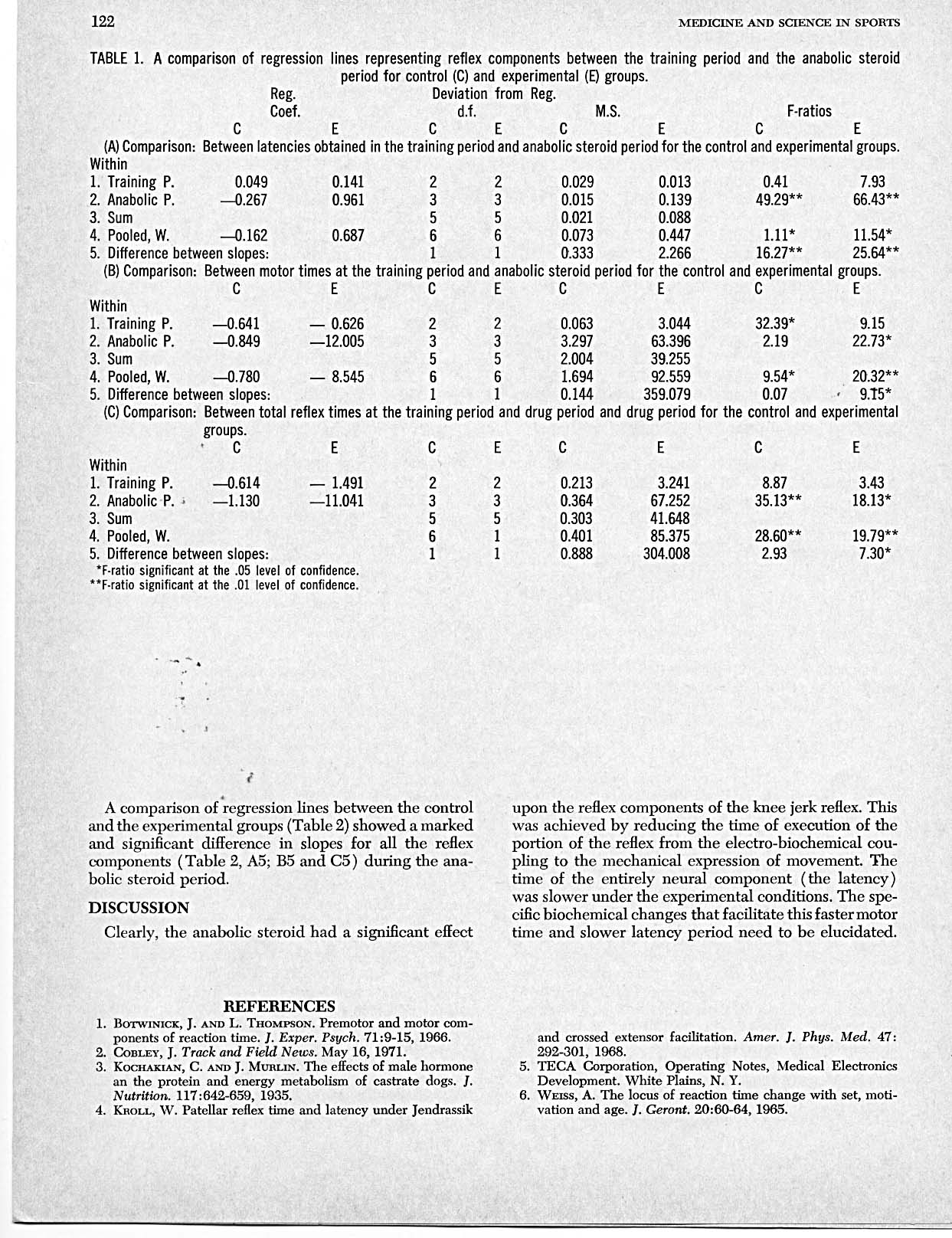The effect of anabolic steroids on reflex components
First study on Anabolic Steroids using Olympic Athletes.
By Gideon Ariel in Medicine and Science in Sports on Monday, May 1, 1972
The Effect of Anabolic Steroids on Reflex Components
This 1972 study, published in Medicine and Science in Sports, investigated the impact of anabolic steroids on the nervous system by measuring various reflex components of the knee jerk reflex. The study used a double-blind technique and found that the anabolic steroid Dianabol significantly affected the reflex components of the six male subjects involved. The results showed significantly faster Motor Times and significantly slower Latencies.
The study concluded that the anabolic steroid acted upon the central nervous system and the biochemical processes involved in the reflex. The work of Koehakian and Murlin provides the basis for the use of anabolic steroids, which have proven clinical value in the treatment of conditions where protein synthesis and reduced nitrogen loss is desired.
However, the effects of anabolic steroids on the nervous system remain unclear. The specific biochemical changes that facilitate faster motor time and slower latency period need further investigation.
Tip: use the left and right arrow keys
MEDICINE AND SCIENCE IN SPORTS Vol. 4, No. 2, pp. 120-123,1972
The effect of anabolic steroids
on reflex components
ABSTRACT. The purpose of this study was to investigate the effect of anabolic steroid upon the nervous system by measuring the various reflex components of the knee jerk reflex. A double blind technique was used in this study. The anabolic steroid (Dianabol) had a significant effect upon the reflex components of 6 male subjects. Significantly faster Motor Times and significantly slower Latencies were obtained. From) these results it can be concluded that the anabolic steroid acted upon the central nervous system and the biochemical processes involved in the reflex.
The work of koehakian and Murlin (3) provides the basis for the use of anabolic steroids. The pharmacological properties of these steroids have proved of clinical value in the treatment of conditions where protein synthesis and reduced nitrogen loss is desired. Their use has been extended by "power event" athletes who have attempted to (levelop dnereased muscular contractile force. The use of anabolic steroids for this purpose is reported to be widespread (2).
The effects of anabolic steroids upon the nervous system are still unclear. The purpose of this study was to investigate the effect of an anabolic steroid (hiethandrostenolone) upon the nervous system by measuring the knee jerk reflex. This reflex arc, which is initiated by striking the patellar ligament has been subdivided into three components: the reflex latency, the motor time, and the total reflex time, in accordance with the nomenclature of WVciss (6). In general, the subdivisions used by Weiss (6), and Botwinick and Thompson (1), to fractionate reaction tinge were used in the present study to fractionate reflex time. Therefore, the reflex latency is the time from mechanical stimulation of the patellar ligament to the appearance of an action poten
This research was supported by a grant to Dr. Benjamin Ricci from a Public Health Service Biomedical Services Grant No. FR07048-05 awarded to the University of Massachusetts.
Submitted for publication October, 1971.
GIDEON ARIEL AND WILLIAM SAVILLE
Department of Exercise Sciences Mdversity of Massachusetts Amherst, Massachusetts 01002
tial at the motor point of the rectus femoris muscle. The motor time is the period from the appearance of an action potential at the motor point to the mechanical movement of the leg by the muscle. Thee total reflex time is the time from the mechanical stimulation of the tendon to the mechanical movement of the leg. Kroll (4) has postulated the relative independence of these components. This independence suggests different mechanisms. The effect of anabolic steroids upon the afferentefferent nervous pathway and the clectro-biochemical exchange period was examined to acid to present knowledge which is already aware of consistent changes in the biochemical parameters.
METHODS
Six male university students, aged 18-22 years, served as subjects in this study. Their height averaged 1.82 cm and their weight 97 kg. The experiments were conducted weekly on two successive days during an eightweek period. In order to minimize the effect of diurnal variation, testing was done between 8 p.m. and 10 p.m.
All subjects were varsity athletes who had experienced two years of weight training. For a period of four months prior to the beginning of the experimental period all the subjects trained for five days and performed test trials on the sixth and seventh days. This procedure was followed for the 8 weeks study period. During the second, third, and fourth weeks of the study all subjects were given placebo pills daily with the information they contained 10 mg of Dianabol (Methandrostenolone), an oral anabolic steroid. From the fourth to the eighth weeks a double blind technique was used. Three of the subjects received 10 mg of the oral anabolic steroid and the remaining three subjects continued to receive the placebo. The oral anabolic steroid and the placebo
120
ANABOLIC STEROIDS ON REFLEX COMPONENTS
121
were assigned to the subjects by code by the University Health Service and the investigators were not informed what the subject actually received until after the 8 weeks testing period.
Total patellar reflex time and reflex latency were obtained on the right limb. A Lafayette knee reflex apparatus was used with an adjustable hammer to deliver a strike to the patellar ligament. The hammer was released at a 60 degree angle. The subject was comfortably seated with his heel held relaxed against an adjustable plate depressing a microswitch. The recording was started when a microswitch in the hammer was activated by the strike. This microswitch closed the circuit, causing an electric Hunter clock counter to start when contact was made by the hammer head with the patellar ligament. As soon as the reflex arc was completed. a mechanical movement of the limb caused the subject's heel to lose contact with the heel plate which again opened the circuit and stopped the electric clock. The time elapsed is the total reflex time.
Electrodes for recording the EMG were placed directly over the rectus femoris motor point which was located by the standard procedures indicated in the TECA Operator's manual (5) for the variable pulse generator and chronaximcter model CH3. The electrodes were connected to the TECA Electrornyograph model B2 oscilloscope. At the time when the hammer struck the patellar ligament, a beam swept across the oscilloscope, and as the nerve impulse reached the motor point electrodes, a spike potential was displayed on the oscilloscope. This time interval was the latency. Ten reflex trials were taken consecutively on each subject at each testing session.
Data are reported for the control (placebo) and the experimental groups (Dianabol), and comparisons between the training period (1st four weeks) and the anabolic steroid period (last four weeks) have been statistically tested.
RESULTS
Figure 1 presents the relative percentages of each reflex component in the training and anabolic steroid periods for both the control and the experimental groups. Only slight changes are seen between the percentages of the different components for the control group. However, the effect of the anabolic steroid on the experimental group is marked. The reflex latency of 11.21 percent changed to 19.74 percent during the anabolic steroid period; the motor time component decreased from 88.79 percent to 80.26 percent of the total reflex time during the same period. These changes in the motor time produced a greatly reduced total reflex time. The mean motor time of 108.28 ms was reduced to 66.33 ms for the experimental group. Figure 2 presents the changes in the reflex components for both control and experimental groups for the same two periods. There was an increase in the length of the reflex latency component of the experimental group during
Figure 2-Reflex components in training and anabolic periods.
the anabolic steroid period. This lengthening of the latency component was statistically significant despite the small mean difference. The faster motor time and its effect upon the total reflex time are clearly seen to be more marked for the experimental group who received the anabolic steroid during this period.
A comparison of regression lines between the training and the anabolic steroid periods yields the following results (Table 1). The control and the experimental groups demonstrated significant differences between the slopes of the regression lines for latencies (Table 1, A5). The regression slopes were significantly different between the training and the anabolic steroid periods in the motor and total reflex times for the experimental group (Table 1, B5 and C5).
CONTROL GROUP
EXPERIMENTAL GROUP
TOTAL LATENCY REFLEX
TIME
REFLEX COMPONENTS e Mwns sgnifi
''Means sgnrt.wnIl, diff.rwl al 01 1,5.1
Figure 1-Relative percentage of reflex components.
130
TRAINING PERIOD
ANABOLIC SrEROIO PERIOD
120
110
t00 90
u so
N
f TO W
60
I
50
40 30 20
� .TOTAL REFLEX TIME
� MOTOR TIME
� . LATENCY
10
~ 5n.
I
2
3
4 5 WEEKS
6
T
8
122
MEDICINE AND SCIENCE IN SPORTS
TABLE 1. A comparison of regression lines representing reflex components between the training period and the anabolic steroid period for control (C) and experimental (E) groups. Reg. Deviation from Reg.
Coef. d.f. M.S. F-ratios
C E C E C E C E
(A) Comparison: Between latencies obtained in the training period and anabolic steroid period for the control and experimental groups.
Within 0.049 0.141 2 2 0.029 0.013 0.41 7.93
Training P.
Anabolic P. -0.267 0.961 3 3 0.015 0.139 49.29** 66.43**
Sum 5 5 0.021 0.088
Pooled, W. -0.162 0.687 6 6 0.073 0.447 1.11* 11.54*
Difference between slopes: 1 1 0.333 2.266 16.27** 25.64**
C E C E C E C E
Within -0.641 - 0.626 2 2 0.063 3.044 32.39* 9.15
Training P.
Anabolic P. -0.849 -12.005 3 3 3.297 63.396 2.19 22.73*
Sum 5 5 2.004 39.255
Pooled, W. -0.780 - 8.545 6 6 1.694 92.559 9.54* 20.32**
Difference between slopes: 1 1 0.144 359.079 0.07 9.15*
(C) Comparison: Between total reflex times at the training period and drug period and drug period for the control and experimental
groups.
(B) Comparison:
Between motor times at the training period and anabolic steroid period
for the control and experimental groups.
C E C E C E C E
Within - 1.491 2 2 0.213 3.241 8.87 3.43
Training P. -0.614
Anabolic P. -1.130 -11.041 3 3 0.364 67.252 35.13** 18.13*
Sum 5 5 0.303 41.648
Pooled, W. 6 1 0.401 85.375 28.60** 19.79**
Difference between slopes: 1 1 0.888 304.008 2.93 7.30*
*F-ratio significant at the .05 level of confidence. **F-ratio significant at the .01 level of confidence.
A comparison of regression lines between the control and the experimental groups (Table 2) showed a marked and significant difference in slopes for all the reflex components (Table 2, A5; B5 and C5) during the anabolic steroid period.
DISCUSSION
Clearly, the anabolic steroid had a significant effect REFERENCES
- BoTWINICK, J. AND L. THOMPSON. Premotor and motor com
ponents of reaction time. J. Exper. Psych. 71:9-15, 1966.
COBLEY, J. Track and Field News. May 16, 1971.
KOCIIAKIAN, C. AND J. MURLIN. The effects of male hormone an the protein and energy metabolism of castrate dogs. J. Nutrition. 117:642-659, 1935.
KROLL, W. Patellar reflex time and latency under Jendrassik
upon the reflex components of the knee jerk reflex. This was achieved by reducing the time of execution of the portion of the reflex from the electro-biochemical coupling to the mechanical expression of movement. The time of the entirely neural component (the latency) was slower under the experimental conditions. The specific biochemical changes that facilitate this faster motor time and slower latency period need to be elucidated.
and crossed extensor facilitation. Amer. J. PhDs. Med. 47: 292-301, 1968.
TECA Corporation, Operating Notes, Medical Electronics Development. White Plains, N. Y.
WEiss, A. The locus of reaction time change with set, motivation and age. J. Geront. 20:60-64, 1965.
ANABOLIC STEROIDS ON REFLEX COMPONENTS
123
TABLE 2. A comparison of regression lines representing reflex components between the control and the experimental groups for the training period (T) and the anabolic period (A). Reg. Deviation from Reg.
Coef. d.f. M.S. F-ratios
T A T A T A T A
(A) Comparison: Between latencies of the control and the experimental groups for the training and anabolic steroid periods.
Within
Control 0.049 -0.261 2 3 0.029 0.016 0.41 41.99**
Experimental 0.141 0.961 2 3 0.013 0.139 7.93 66.43**
Sum 4 6 0.210 0.776
Pooled, W. 0.095 0.350 5 7 0.021 1.133 980.41** 2.35
1 1 0.021 7.466 1.00 96.22**
- Direrence between slopes:
(B) Comparison: Between motor times of the control and the experimental groups for the training and anabolic steroid periods.
T A T A T A T A
Within -0.641 - 0.849 2 3 0.063 1.762 32.39* 4.09
Control
Experimental -1.626 -12.005 2 3 3.044 63.396 4.34 22.73*
Sum 4 6 1.553 32.579
Pooled, W. -1.134 - 6.427 5 7 1.728 116.822 41.42** 13.35**
1 1 2.426 722.282 1.56 22.20**
- Difference between slopes:
(C) Comparison: Between total reflex times of the control and the experimental groups for the training and anabolic steroid periods.
T A T A T A T A
Within -0.614 - 1.300 2 3 0.213 0.364 8.87 35.13**
Control
Experimental -1.491 -11.041 2 3 3.241 67.252 3.43 18.13*
Sum 4 6 1.727 33.808
Pooled, W. -1.052 - 6.085 5 7 1.766 99.141 8.99* 17.57**
1 1 1.923 499.140 1.11 14.53**
- Difference between slopes:
*F-ratio significant at the .05 level of confidence. **F.ratio significant at the .01 level of confidence.




